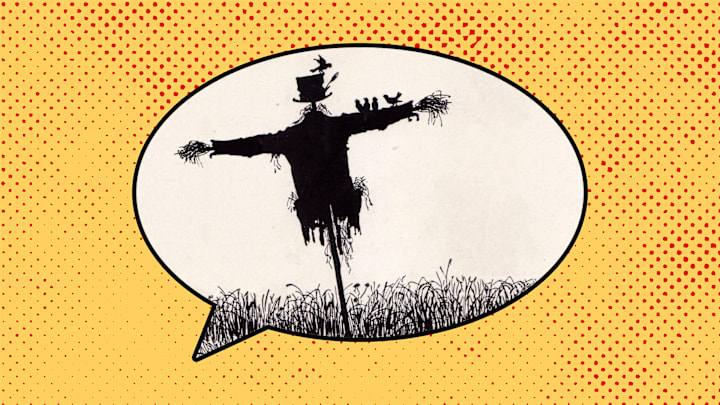Scarecrow is by far the most popular term for a figure meant to keep birds away from crops. You could even argue that it’s the only term for such a figure in use today (with the possible exception of straw man). But history is bursting with entertaining synonyms for scarecrow—here are 11 of our favorites, from blencher to moggy.
- Blencher
- Bogle
- Potato-bogle
- Tattie boodie
- Worricow
- Hobidy-booby
- Jack-of-straw
- Flay-crake
- Gally-crow
- Shaw-fowl
- Moggy
Blencher
In the 16th century, per the Oxford English Dictionary, a blencher was any “person or thing employed to turn or frighten away”—a category that included scarecrows. The term comes from the Old English blench, meaning “to cheat, elude, turn aside.”
Bogle
Bogle can be used as a scarecrow synonym, but its broader meaning covers phantoms, goblins, and any other frightful creature (or person).
Potato-bogle

A potato-bogle, meanwhile, is a scarecrow that has a potato head and/or is stationed in a potato field. The term originated in 19th-century Scotland.
Tattie boodie
And 19th-century northeastern Scotland gave us tattie boodie, another fanciful nickname for a scarecrow in a potato field (or any scarecrow). Tattie means “potato,” and boodie is basically the Scottish equivalent of bogle—any frightful creature.
Worricow
Yet another Scottish scarecrow stand-in is worricow, which dates back to the early 18th century and could also be used to describe a scary-looking person. If it’s preceded by the, however, it’s referring to the devil.
Hobidy-booby
The OED’s only citation for hobidy-booby comes from an early-18th-century book called Man’s Treachery to Woman: “His Legs are distorted so … that he looks like a Hobidy-Booby, prop’d up with a couple of Crooked Billets.” The dictionary’s best guess is that hobidy-booby meant “scarecrow,” from booby in the “blundering person” sense. The hobidy may have been inspired by similar words like Hobbididance, the name of an evil sprite featured in an old English folk dance called the “morris.” Shakespeare even mentioned Hobbididance in King Lear. “Five fiends have been in poor Tom at once,” Edgar says, “of lust; as Obidicut; Hobbididence, prince of darkness; Mahu, of stealing; Modo, of murder; Flibbertigibbet, of mopping and mowing, who since possesses chambermaids and waiting women.”
Jack-of-straw

Jack-o’-lantern isn’t the only autumnal Jack in the books; there’s also Jack-of-straw, a synonym for scarecrow or “a man without substance or financial means.” At least he’s not short on straw.
Flay-crake
Crake is another word for a crow or raven, and flay implies inflicting some serious pain on one. Evidently a scarecrow’s job description in 1788—when flay-crake first appeared in print—went beyond mere scare tactics.
Gally-crow
Gally, which entered the written record in the 17th century, means “to frighten, daze, scare, [or] startle,” from the Old English verb a-gælwan, “to alarm.” So gally-crow is about as direct a synonym for scarecrow as you can get.
Shaw-fowl

Shaw-fowl—which could refer to a scarecrow or an artificial bird used for shooting practice—had its heyday in the 17th century, but nobody really knows where the shaw came from. The first written mention comes from a work by Anglican bishop Richard Montagu, who used it throughout his writings.
Moggy
Moggy is a British colloquialism that people have used for a cat, a calf, a cow, a girl, a guy, and any stuffed figure—scarecrows included, though that sense was fairly rare. (Moggy also features heavily in the story of how Peggy became a nickname for Margaret.)
Discover More About Words:
